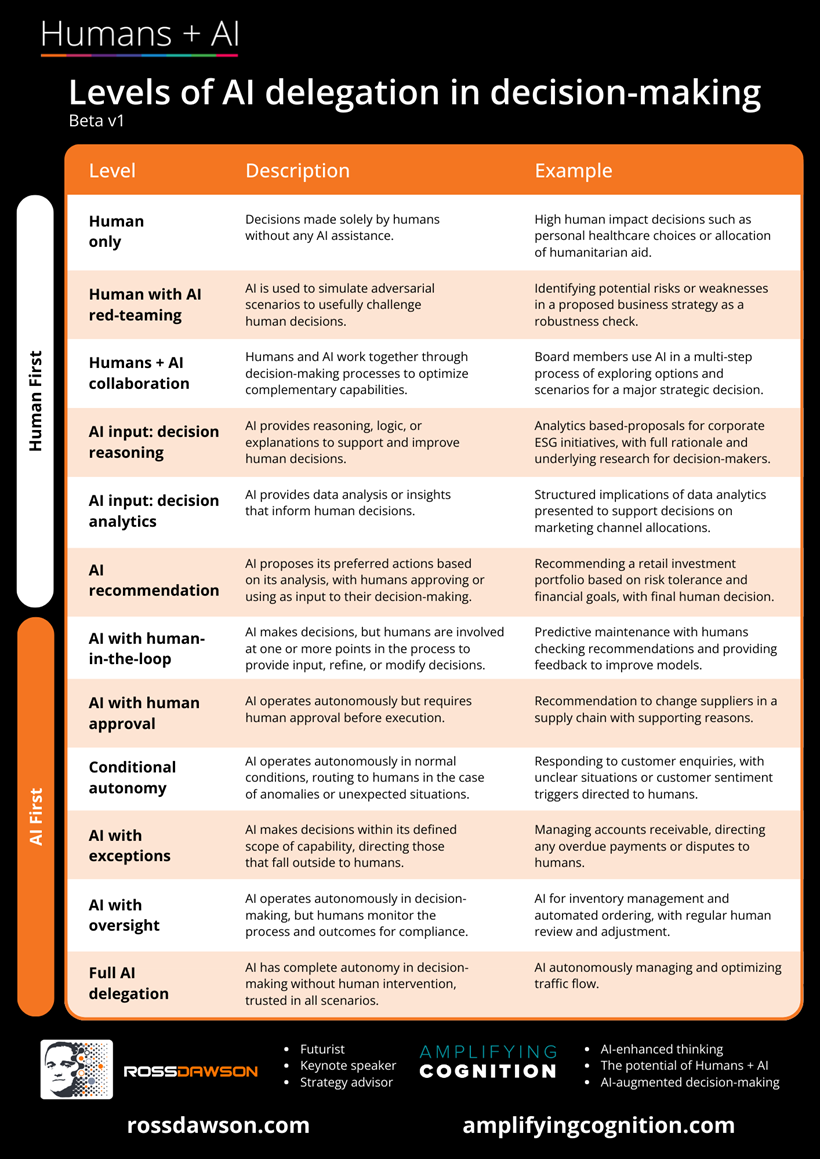Framework: Levels of AI delegation in decision-making
Soon virtually every decision will involve AI. For every decision we make, the critical first step is to determine the level of AI delegation. And then select the specific Humans + AI architecture most appropriate to the decision.
This framework is the latest iteration of the AI decision-making delegation frameworks I’ve been developing and using with clients, made concise for communication and easy digestion.
My frameworks are always works-in-progress, so please share any thoughts or comments on LinkedIn to help shape the next version!! 🙏 See more Humans + AI frameworks.
AI delegation levels
Human only
Description: Decisions made solely by humans without any AI assistance.
Example: High human impact decisions such as personal healthcare choices or allocation of humanitarian aid.
Human with AI red-teaming
Description: AI is used to simulate adversarial scenarios to usefully challenge human decisions.
Example: Identifying potential risks or weaknesses in a proposed business strategy as a robustness check.
Humans + AI collaboration
Description: Humans and AI work together through decision-making processes to optimize complementary capabilities.
Example: Board members use AI in a multi-step process of exploring options and scenarios for a major strategic decision.
AI input: decision reasoning
Description: AI provides reasoning, logic, or explanations to support and improve human decisions.
Example: Analytics based-proposals for corporate ESG initiatives, with full rationale and underlying research for decision-makers.
AI input: decision analytics
Description: AI provides data analysis or insights that inform human decisions.
Example: Structured implications of data analytics presented to support decisions on marketing channel allocations.
AI recommendation
Description: AI proposes its preferred actions based on its analysis, with humans approving or using as input to their decision-making.
Example: Recommending a retail investment portfolio based on risk tolerance and financial goals, with final human decision.
AI with human-in-the-loop
Description: AI makes decisions, but humans are involved at one or more points in the process to provide input, refine, or modify decisions.
Example: Predictive maintenance with humans checking recommendations and providing feedback to improve models.
AI with human approval
Description: AI operates autonomously but requires human approval before execution.
Example: Recommendation to change suppliers in a supply chain with supporting reasons.
Conditional autonomy
Description: AI operates autonomously in normal conditions, routing to humans in the case of anomalies or unexpected situations.
Example: Responding to customer enquiries, with unclear situations or customer sentiment triggers directed to humans.
AI with exceptions
Description: AI makes decisions within its defined scope of capability, directing those that fall outside to humans.
Example: Managing accounts receivable, directing any overdue payments or disputes to humans.
AI with oversight
Description: AI operates autonomously in decision-making, but humans monitor the process and outcomes for compliance.
Example: AI for inventory management and automated ordering, with regular human review and adjustment.
Full AI delegation
Description: AI has complete autonomy in decision-making without human intervention, trusted in all scenarios.
Example: AI autonomously managing and optimizing traffic flow.




